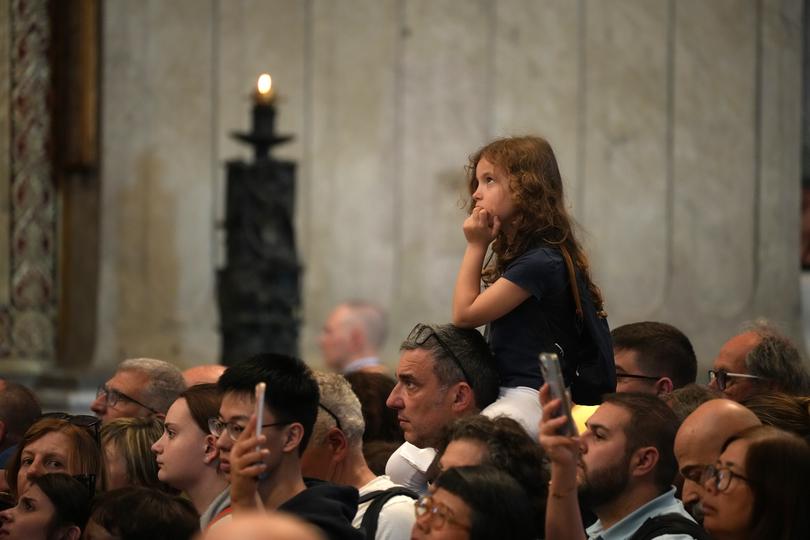THE WASHINGTON POST: Pope Francis lies in state as thousands of faithful, and others, bid farewell

This is not how she thought she would see her pope.
A Catholic pilgrim from southern India, Mary Eliza Sajeev, 19, exited the gaping doors of St Peter’s Basilica on Wednesday, stoic with her family after a brief glimpse of the ashen man in a wood-sided coffin. She had waited 3½ hours for a glance lasting a few seconds. Before leaving India for Europe on Monday, she thought she would see Pope Francis alive. She had seen the images from Easter Sunday of Francis in the popemobile amid a massive crowd.
Before her flight boarded, her family heard the news. Francis had died.
Sign up to The Nightly's newsletters.
Get the first look at the digital newspaper, curated daily stories and breaking headlines delivered to your inbox.
By continuing you agree to our Terms and Privacy Policy.On Wednesday, the Roman Catholic Church began three days of viewings. It said Francis’s “mortal remains” would lie in state ahead of his ceremonial funeral Saturday, which is drawing dignitaries and world leaders, including President Donald Trump, to Vatican City.
The throngs lining up Wednesday amounted to a diverse mix. They spoke many languages; some were Catholics, though many were not. A few sang religious hymns to comfort themselves in the slowly snaking lines under the Roman sun, encouraging others to join in. Others used their smartphones. Nearly 20,000 had viewed the body by 7.30pm, and lines were so long that the Vatican said it was considering extending the first day’s viewing hours beyond a scheduled midnight cutoff.
They came to mark history, to snap a photo, to tell others they were here. Sajeev came to bid goodbye to a man she had never met but felt she knew.
“I live very far, but he was always close to me. He was my pope, or that’s how I felt,” she said, speaking softly. His call to charity, Sajeev said, had led her 55-year-old mother, Anila, to bring her along to make donations to the poor back in their home state of Kerala.
“He was a kind man. Everything in the world now is about luxury, about wanting this or that. About trying to put yourself first. But Francis told us not to. He taught us humility. To put others first, to help the poor, to do good.”
Following his death, the pope’s body was moved from his rooms at Casa Santa Marta, the boardinghouse that served as the papal household, to the boardinghouse chapel. Early Wednesday, the ceremonial translation - or transfer - of the pope’s body from Casa Santa Marta to St Peter’s unfolded as an exercise in the high rites of the Roman Catholic Church.
Eighty cardinals already in Rome sat solemnly in the vaulted chapel at Santa Marta, with some of the church’s more conservative princes grouping together in what appeared to be a foreshadowing of the coming conclave to choose a new pope. Other cardinals have been summoned and are en route.
The date of the conclave - the secretive meeting inside the Sistine Chapel to select the next pontiff - will not be announced until after Francis’s funeral, Vatican officials have said. Planning is already underway, though it cannot take place until at least nine days after the funeral - a traditional period of grief. A congregation of cardinals, however, has already begun meeting, taking an oath Tuesday to observe the norms governing the period of “sede vacante,” when the Vatican is without a pope. It will also prepare for the papal funeral and the lead-up to the conclave. The conversations are held behind closed doors.
Adorned in elaborately embroidered crimson robes, Cardinal Kevin Joseph Farrell, the Vatican’s camerlengo, or chamberlain, sprinkled the pope’s coffin with holy water from a silver orb before offering a liturgy.

“Look kindly, Lord, on the life and works of your servant, our Pope Francis,” he said. “Welcome him into the dwelling of perpetual light and peace, and grant that your faithful people may follow fervently in his footsteps, bearing witness to the Gospel of Jesus.”
The pope’s body, in ceremonial liturgical vestments, including the miter headdress that symbolised his position as the bishop of Rome, rested on a red cloth inside a wood-sided coffin, his hands clutching a rosary. Fourteen pallbearers carried the coffin in high procession on a red platform, surrounded in turn by dark-cassocked monks in red stoles and members of the Vatican Swiss Guard wearing traditional yellow, blue and red uniforms and high helmets.
As the procession - including cardinals, bishops and priests - passed through the Vatican’s Santa Marta and First Roman Martyrs squares, the Holy See’s ancient cobblestones echoed with chants in Latin. From the Arch of the Bells, the procession passed into St Peter’s Square, arriving to restrained applause from a crowd. Onlookers clicked their phones as the body was carried through the parvis, or exterior courtyard, where the pope’s funeral will be held Saturday, then up the stairs and into St Peter’s Basilica.
Francis, the first Latin American pope as well as the first Jesuit - a religious order adhering to vows of poverty - requested a less-lofty, less-remote public viewing. Inside the Basilica, Francis’s casket was kept on a ramp facing the pews, rather than on an elevated bier, as happened with past popes. It rested before the Baldacchino, the bronze canopy by Gian Lorenzo Bernini. His coffin was flanked by two members of the Swiss Guard.
The lying in state of popes is a part of Catholic tradition, an echo of the venerations afforded to saints. Some who stood in line Wednesday spoke about an inevitable campaign to canonise Francis - as John Paul II was - though such processes can only officially start five years after a death.

So great were the vast numbers viewing John Paul II in 2005 that authorities were forced to shut down lines. In the first days of 2023, an estimated 200,000 mourners paid last respects to Benedict XVI. The viewings for Francis, the Vatican said, will conclude with a rite of the “closing of the coffin” at 8pm Friday, local time.
Frank Canavan, from Edmonton, Canada, arrived with his wife, Evelyn, at 7 am Wednesday - some four hours before the doors opened to public. Francis “was very loving,” he said. “He was a pope who opened up the church and had a philosophy of including everybody.” Viewing the pope in state “was very humbling, very peaceful,” he said. “I thought it would be sad. But it was more triumphant. This is the certainty of somebody who lived his life for God.”
He embraced Francis as an imperfect pope. “He wasn’t always nice in his early years, but he learned from that. And by the time he was in Buenos Aires (as archbishop), he lived a humble life. He abrogated all the trappings of being a prince of the church. He lived the life he said we should also live. It was an example for all of us.”

Camilla Melis, 27, a Sardinian who lives in Rome, came with her mother. Raised Catholic, she doesn’t practice but admired Francis. “For me, it’s about the historical moment. And I did feel more connected to this pope than the others before. He was down to earth. I also appreciated that he was not European. A lot of young people are like me, getting more distant from the church, and I feel like his spirit brings us closer,” she said.
Federica Pepe, 21, left her southern Italian town near Pompeii at 5am with her devout, elderly mother. Five and a half hours later, she exited St. Peter’s after viewing Francis. She no longer practices but said she would have made the trip even if it hadn’t been her mother’s wish.
“I’m here for myself,” she said. “Knowing that the figure who represented the church was also representing modernity filled me with joy. I’m talking about him siding with (LGBTQ+) rights. Regardless of the church’s limitations, the pope has made an attempt at changing some things. Even as an agnostic - not an atheist - I still believe he was a great person.”
© 2025 , The Washington Post
